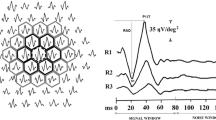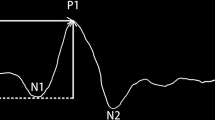Abstract
Purpose
To determine neuroretinal function with multifocal electroretinogram (mfERG) in diabetic subjects without retinopathy.
Methods
Multifocal electroretinogram (mfERG) was performed in 18 eyes of 18 diabetic subjects without retinopathy and 17 eyes of 17 age and gender-matched healthy control participants. Among 18 diabetic subjects, two had type 1 and 16 had type 2 diabetes. MfERG responses were averaged by the retinal areas of six concentric rings and four quadrants, and 103 retinal locations; N1–P1 amplitude and P1-implicit time were analysed.
Results
Average mfERG N1–P1 amplitude (in nv/deg2) of 103 retinal locations was 56.3 ± 17.2 (mean ± SD) in type 1 diabetic subjects, 47.2 ± 9.3 in type 2 diabetic subjects and 71.5 ± 12.7 in controls. Average P1-implicit time (in ms) was 43.0 ± 1.3 in type 1 diabetic subjects, 43.9 ± 2.3 in type 2 diabetic subjects and 41.9 ± 2.1 in controls. There was significant reduction in average N1–P1 amplitude and delay in P1-implicit time in type 2 diabetic subjects in comparison to controls. mfERG amplitude did not show any significant correlation with diabetes duration and blood sugar level. However, implicit time showed a positive correlation with diabetes duration in type 2 diabetic subjects with diabetes duration ≥5 years.
Conclusions
This is the first study in a Nepalese population with diabetes using multifocal electroretinography. We present novel findings that mfERG N1–P1 amplitude is markedly reduced along with delay in P1-implicit time in type 2 diabetic subjects without retinopathy. These findings indicate that there might be significant dysfunction of inner retina before the development of diabetic retinopathy in the study population, which have higher prevalence of diabetes than the global estimate and uncontrolled blood sugar level.




Similar content being viewed by others
References
Yau JW, Rogers SL, Kawasaki R, Lamoureux EL, Kowalski JW, Bek T, Chen S-J, Dekker JM, Fletcher A, Grauslund J (2012) Global prevalence and major risk factors of diabetic retinopathy. Diabetes Care 35:556–564
Ferris F (1996) Early photocoagulation in subjects with either type I or type II diabetes. Trans Am Ophthalmol Soc 94:505
Ghirlanda G, Di Leo MA, Caputo S, Cercone S, Greco AV (1997) From functional to microvascular abnormalities in early diabetic retinopathy. Diabetes Metab Rev 13:15–35
Shirao Y, Kawasaki K (1998) Electrical responses from diabetic retina. Prog Retin Eye Res 17:59
Tzekov R, Arden G (1999) The electroretinogram in diabetic retinopathy. Surv Ophthalmol 44:53–60
Barber AJ (2003) A new view of diabetic retinopathy: a neurodegenerative disease of the eye. Prog Neuropsychopharmal 27:283–290
Fortune B, Schneck ME, Adams AJ (1999) Multifocal electroretinogram delays reveal local retinal dysfunction in early diabetic retinopathy. Invest Ophthalmol Vis Sci 40:2638–2651
Arden GB, Hamilton AM, Wilson-Holt J, Ryan S, Yudkin JS, Kurtz A (1986) Pattern electroretinogram become abnormal when background diabetic retinopathy deteriorates to a preproliferative stage: possible use as a screening test. Br J Ophthalmol 70:330–335
Nesher R, Trick GL (1991) The pattern electroretinogram in retinal and optic nerve disease: a quantitative comparison of the pattern of visual dysfunction. Doc Ophthalmol 77:225–235
Jenkins TC, Cartwright JP (1990) The electroretinogram in minimal diabetic retinopathy. Br J Ophthalmol 74:681–684
Harrison WW, Bearse MA, Ng JS, Jewell NP, Barez S, Burger D, Schneck ME, Adams AJ (2011) Multifocal electroretinograms predict onset of diabetic retinopathy in adult subjects with diabetes. Invest Ophthalmol Vis Sci 52:772–777
Bearse MA Jr, Adams AJ, Han Y, Schneck ME, Ng J, Bronson-Castain K, Barez S (2006) A multifocal electroretinogram model predicting the development of diabetic retinopathy. Prog Retin Eye Res 25:425
De Juan Jr E (July 6, 1999) Use of a protein tyrosine kinase pathway inhibitor in the treatment of diabetic retinopathy. U.S. Patent 5,919,813
Colwell JA (1997) Aspirin therapy in diabetes. Diabetes Care 20:1767–1771
Engerman R, Bloodworth J, Nelson S (1977) Relationship of microvascular disease in diabetes to metabolic control. Diabetes 26:760–769
Singh D, Bhattarai M (2003) High prevalence of diabetes and impaired fasting glycaemia in urban Nepal. Diabet Med 20:170–171
Shrestha U, Singh D, Bhattarai M (2006) The prevalence of hypertension and diabetes defined by fasting and 2-h plasma glucose criteria in urban Nepal. Diabet Med 23:1130–1135
Shaw J, Sicree R, Zimmet P (2010) Global estimates of the prevalence of diabetes for 2010 and 2030. Diabetes Res Clin Pr 87:4–14
Hood DC, Bach M, Brigell M, Keating D, Kondo M, Lyons JS, Marmor MF, McCulloch DL, Palmowski-Wolfe AM (2012) ISCEV standard for clinical multifocal electroretinography (mfERG) (2011 edition). Doc Ophthalmol 124:1–13
Han Y, Bearse M, Schneck M, Barez S, Jacobsen C, Adams A (2004) Towards optimal filtering of “standard” multifocal electroretinogram (mfERG) recordings: findings in normal and diabetic subjects. Br J Ophthalmol 88:543–550
Schneck M, Bearse M, Han Y, Barez S, Jacobsen C, Adams A (2004) Comparison of mfERG waveform components and implicit time measurement techniques for detecting functional change in early diabetic eye disease. Doc Ophthalmol 108:223–230
Hood DC, Frishman LJ, Saszik S, Viswanathan S (2002) Retinal origins of the primate multifocal ERG: implications for the human response. Invest Ophthalmol Vis Sci 43:1673–1685
Hare WA, Ton H (2002) Effects of APB, PDA, and TTX on ERG responses recorded using both multifocal and conventional methods in monkey. Doc Ophthalmol 105:189–222
Laron M, Bearse MA, Bronson-Castain K, Jonasdottir S, King-Hooper B, Barez S, Schneck ME, Adams AJ (2012) Association between local neuroretinal function and control of adolescent type 1 diabetes. Invest Ophthalmol Vis Sci 53:7071–7076
Kurtenbach A, Langrova H, Zrenner E (2000) Multifocal oscillatory potentials in type 1 diabetes without retinopathy. Invest Ophthalmol Vis Sci 41:3234–3241
Shimada Y, Li Y, Bearse MA, Sutter EE, Fung W (2001) Assessment of early retinal changes in diabetes using a new multifocal ERG protocol. Br J Ophthalmol 85:414–419
Kim SJ, Song SJ, Yu HG (2007) Multifocal electroretinogram responses of the clinically normal retinal areas in diabetes. Ophthalmol Res 39:282–288
Kaiser PK (2009) Prospective evaluation of visual acuity assessment: a comparison of Snellen versus ETDRS charts in clinical practice (An AOS Thesis). Trans Am Ophthalmol Soc 107:311
Ozawa GY, Bearse MA, Bronson-Castain KW, Harrison WW, Schneck ME, Barez S, Adams AJ (2012) Neurodegenerative differences in the retinas of male and female patients with type 2 diabetes. Invest Ophthalmol Vis Sci 53:3040–3046
Acknowledgments
The authors would like to thank Beatrix Feigl for comments on a manuscript draft.
Author information
Authors and Affiliations
Corresponding author
Rights and permissions
About this article
Cite this article
Adhikari, P., Marasini, S., Shah, R.P. et al. Multifocal electroretinogram responses in Nepalese diabetic patients without retinopathy. Doc Ophthalmol 129, 39–46 (2014). https://doi.org/10.1007/s10633-014-9447-9
Received:
Accepted:
Published:
Issue Date:
DOI: https://doi.org/10.1007/s10633-014-9447-9




